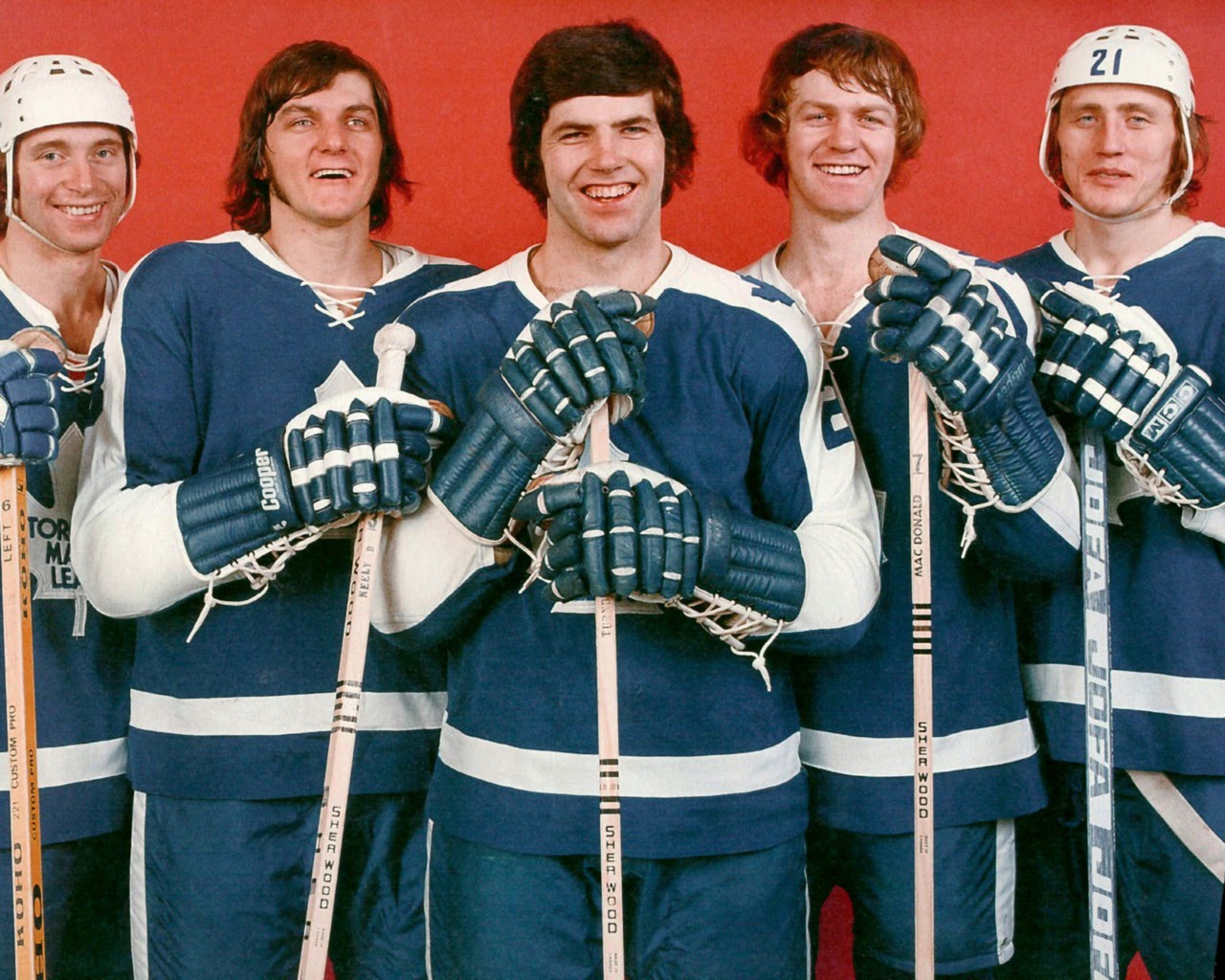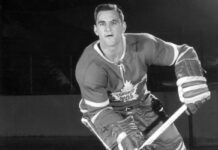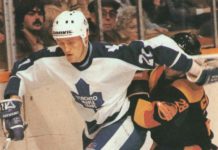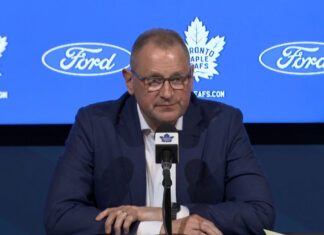Michael Langlois of Vintage Leaf Memories will stop by Maple Leafs Hot Stove throughout the Maple Leafs’ centennial season to provide his reflections on past Leaf teams and players from his sixty-plus years of following the Blue and White.
For those Toronto Maple Leafs followers whose hockey psyche has not already been unalterably damaged, the annual summertime entry draft has been the one constant that has created a genuine sense of hope in recent times.
Every June, fans knew the Toronto Maple Leafs had a top pick baking in the proverbial hockey draft oven—and because of successive seasons of (let’s be honest) pretty dismal play, we’ve been drafting very high. And in recent years, that has netted the organization some awfully nice new pieces, which — along with some shrewd moves by the Shanahan-led management group — has enhanced the level of optimism in Leafland.
As Sammy Pollock (the sage and venerable former General Manager of the then fabulously successful Montreal Canadiens of the mid-1960s through the late 1970s) used to do, the Maple Leafs have done the modern-day Bill Belichick thing and often traded for even more picks. The thinking no doubt being, since drafting is an imprecise science to be sure, the more selections you have, the better your odds of hitting a double or even a home run once in a while—regardless of the round you’re picking in.
So this, in part at least, is why Maple Leaf fans have taken the covers out from over their heads and aren’t afraid to look out into the future any longer: draft picks like Rielly, Nylander, Marner, Brown and Matthews are largely the reason. And interestingly, while those players are certainly an integral part of the club’s future fortunes, they are also already here now, and a huge part of the present. Which is kind of, well, exciting.
Once upon a time: Three picks in the first round
But as noteworthy as some of the recent Maple Leaf drafts have been (with more than one pick in the first round a few years ago), I tend to harken back to a time when the Maple Leafs really struck it rich in a particular draft many years ago. It was the late spring (the draft was in late May, I believe, back in those days) of 1973.
I recall that then Maple Leaf General Manager Jim Gregory was re-shaping the roster after a very poor 1972-73 NHL season. Now, part of the reason the Maple Leafs struggled so badly and missed the playoffs completely was that the fledgling World Hockey Association had come into being. Our owner at the time, Harold Ballard, didn’t like the idea of this “rival” league and evidently never believed it would really get off the ground.
Sadly for Maple Leaf fans, it did, and because Gregory wasn’t able to offer real money to keep guys, the Maple Leafs lost some very important and useful players. The list included future Hall-of-Fame goaltender Bernie Parent (do you remember the Miami Screaming Eagles…?), Rick Ley, a good young defenseman, Brad Selwood, another emerging defender, and a tough two-way center in Jim Harrison. Defenceman Mike Pelyk left as well.
By the end of the 1972-73 season, Gregory was building for the future. He traded Jacques Plante to the Bruins for a first round pick. The team already had its own first rounder and had also acquired yet another selection in the first round. This gave the Maple Leafs three choices in the first fifteen picks in the draft.
McDonald, Neely and Turnbull
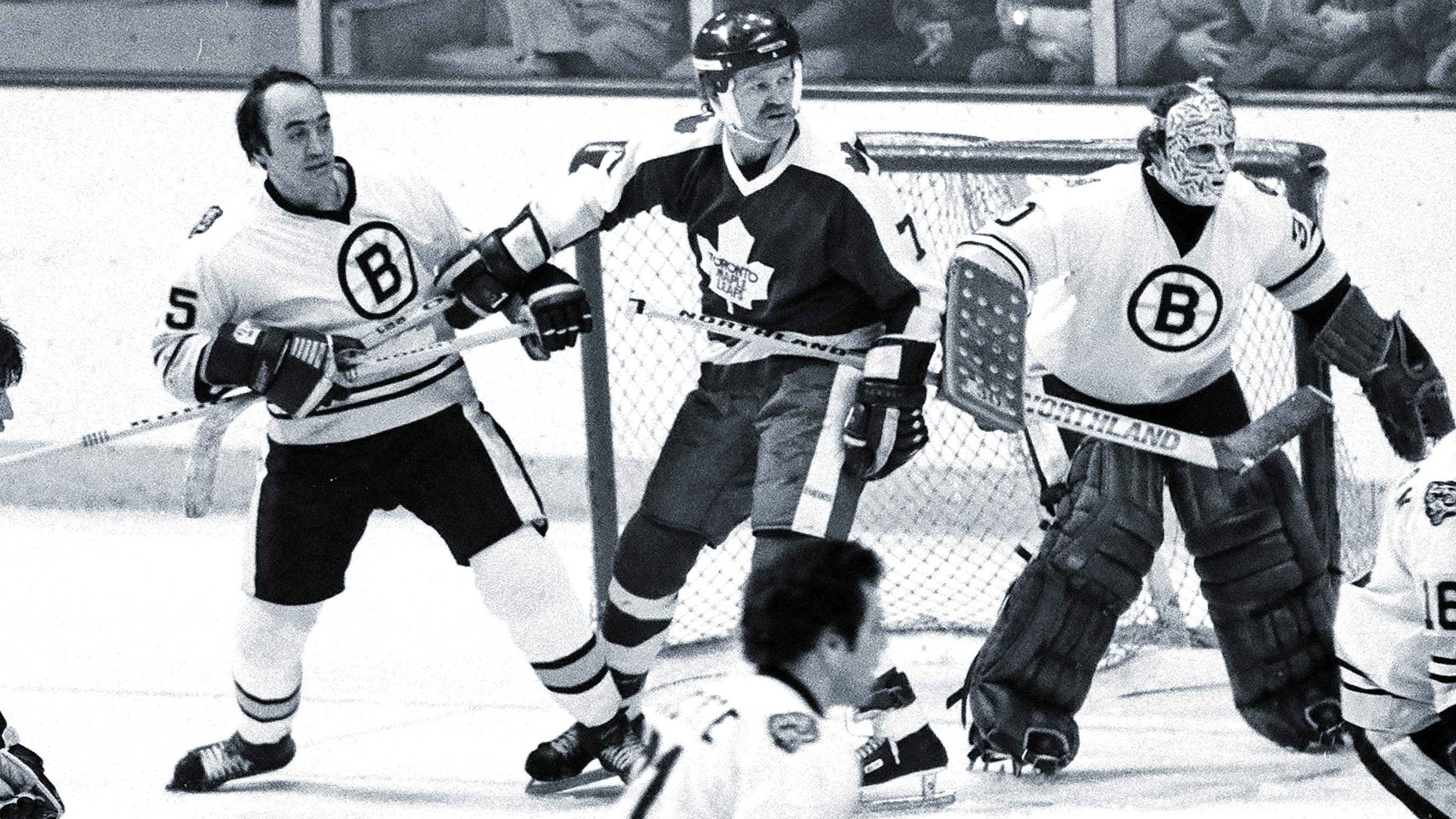
In those days it was pretty tough to follow the draft super closely. No round-the-clock sports radio or television. No internet. No Twitter. But I well knew, as a devoted Maple Leaf fan in my very early 20s, that we had those picks. And I was praying we would get some difference-makers, as we had in the 1970 draft when future captain and Hall-of-Famer Darryl Sittler was chosen eighth overall in the draft.
In the end, we did. I was living in my small hometown in southwestern Ontario in those days, but not close enough to Toronto to hear much in the way of any radio and TV reports about the draft. But I did drive to a nearby town the next morning to grab a copy of The Globe and Mail. I was, to say the least, excited when I discovered whom the Maple Leafs had chosen—Lanny McDonald, Bob Neely and Ian Turnbull.
I knew McDonald was a sniper from the Medicine Hat Tigers out West. I had never actually seen him play, but knew he had been on a line Tom Lysiak, who was considered the best guy in the draft other than Denis Potvin of the Ottawa 67s. McDonald had scored 60-plus goals in his last junior season, and I figured we sure could use some of that. Picked fourth overall, it turned out to be a very good choice.
I had watched Neely play in person a few times in junior games against the old Toronto Marlies (coached by former Maple Leaf Captain George Armstrong) at Maple Leaf Gardens. Neely was very big for the time. But he could skate quite well, had a good shot and certainly seemed to have a promising future. (I noted at the time that he was not really ‘tough’ in the conventional sense for a physically large player at the time. He stood out for his size in junior but less so in the NHL. He could certainly hit but was not a fighter and was, at least in my mind, more of a finesse guy, actually.) He was drafted 10th overall.
Ian Turnbull I had also seen play a few times against the Marlies, including in the playoffs that spring of 1973, as I recall. Now this was a choice I was really excited about. Taken number 15, I thought it was a steal. He played with Potvin in Ottawa his last year of junior after several seasons with the Junior Canadiens in Montreal. Turnbull could skate, shoot, and make plays. I really thought he might actually have more potential than Potvin.
Slow start for Lanny
None of the stories quite ended the way management, fans or likely even the players themselves would have liked. Why? Well, the players each experienced career twists and turns that resulted in them never truly fulfilling their potential in Toronto.
In McDonald’s case, he showed up and right away was placed on a line with his hockey hero, Dave Keon. I remember almost like it was yesterday that in the first game of the 1973-’74 NHL season, McDonald set up at least one (maybe both) of Dave Keon’s two goals in a win over the Sabres on Opening Night at the Gardens. But I also remember that Buffalo forward Richard Martin (a tremendous player in his own right) hammered Lanny with an open ice check that knocked McDonald over. He landed on his head and suffered a concussion. Lanny wasn’t wearing a helmet in that first game, but wore one from then on for the rest of his career.
The Keon-McDonald experiment never really worked. Their styles did not mesh, and maybe as importantly, the two apparently never got along, either. Not sure why, but Keon was nearing the end of his time in Toronto, more and more frustrated by and with Ballard. Some players, I recall reading at the time, were not fans of Keon’s edgy approach with young players. Dave was kind of a Bert Olmstead throwback. He had high expectations for teammates and that did not sit well with everyone, evidently.
In any event, McDonald put up very modest numbers in his first two NHL seasons. He got knocked off the puck quite a bit for a strong young player. And he was hurt off and on, with people wondering if he had what it took to really make his mark. In fact, when the Maple Leafs made the playoffs in the spring of ’74, I seem to recall he was not able to play, diminishing expectations even further.
Turning the corner
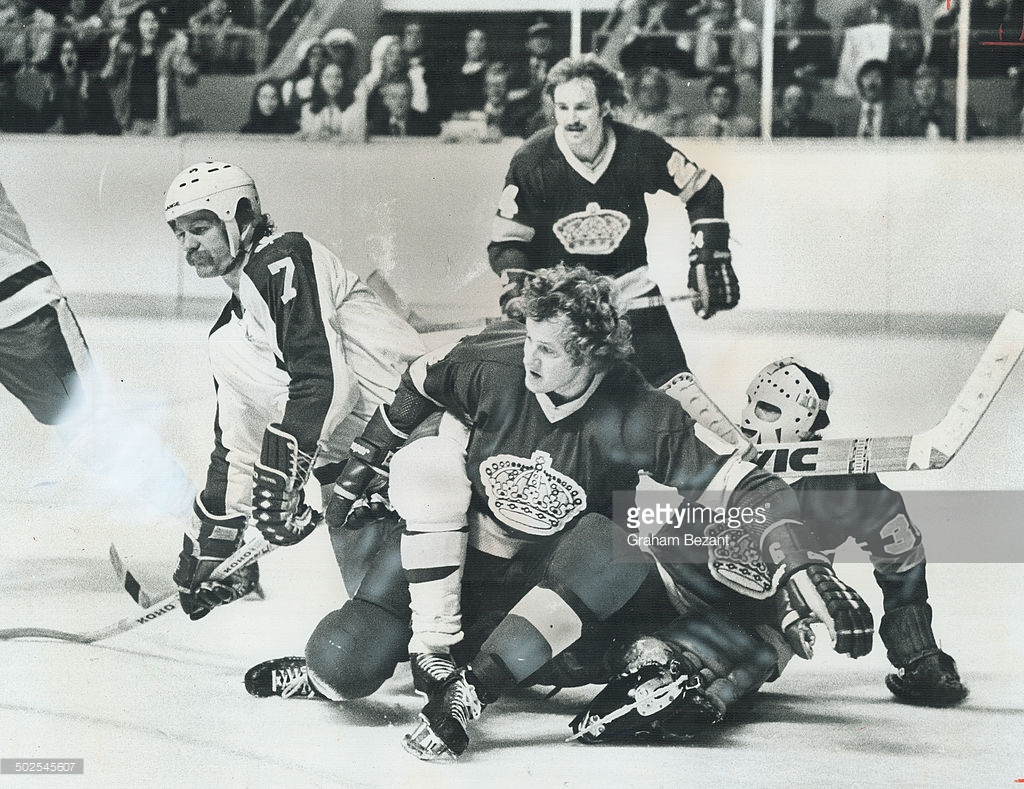
In the summer of 1975, Keon had been unceremoniously hung out to dry by Ballard, and went to the WHA. Darryl Sittler emerged as the Captain, and deservedly so. He right away criticized Ballard for his treatment of longtime Leafs Keon and Normie Ullman. But it was a new era, and Sittler was the leader of the pack.
Early on during the 1975-76 season, a well-known writer for the Toronto Star posited that McDonald would never become the goal scorer that everyone had expected, but it appeared he could at least develop into a useful two-way player. But my analysis was different, as I started to see something quite different. Though I was a somewhat impoverished university student at the time, I dug deep and purchased a pair of Maple Leaf season tickets up in the wonderful old “greys”. (I had seen a notice in the Globe.) So I saw McDonald and the Maple Leafs a lot that season. McDonald started a bit slowly, but he also began to gain confidence. He started using his strength to drive around defensemen off the wing. He utilized his great wrist shot and a booming slap shot. But most importantly, he really became a physical force on the ice. I recall that on consecutive Saturday nights, he hammered Bobby Orr and Denis Potvin with big-time open-ice hip checks at the Gardens, knocking both players head over heels. It was then that I thought, “This guy really can play…”.
McDonald didn’t just catch my eye. That was clear — by the summer of 1976, he was named, along with Sittler, to the roster for the first ever Canada Cup. They played on a line with Montreal winger Bob Gainey (in m mind, one of the best players in the world at that time, despite not being a natural goal scorer) as Canada captured the championship.
McDonald just got better and better as time went on. He scored big goals (including the marvelous and memorable OT winner in Game 7 of the 1978 quarter-finals against Potvin’s heavily-favoured Islanders). He dug the puck out for Sittler, and vice-versa. He continued to hit, and, when necessary, fight. He was a likable, popular Leaf.
But when Punch Imlach was re-hired by Ballard to replace Gregory after over-achieving coach Roger Neilson was let go as head coach by Ballard, everything shifted. Imlach wanted to run things his way, and he believed Sittler was too influential in the Leaf dressing room. When he discovered he couldn’t move Sittler out, he went to his backup plan—he got rid of guys close to Sittler, including, sadly, McDonald.
Lanny was dealt with Joel Quenneville (a name that rings a bell for modern era hockey fans as coach of the three-time Cup champion Hawks) to the Colorado Rockies. The Maple Leafs got two perfectly good players (Pat Hickey and Wilf Paiment) in return, but it was the beginning of the end of the promising Leaf ‘run’ in the late ‘70s. Were it not for the vaunted Canadiens, the Leafs might have made it at least to the finals one of those years. But they just couldn’t quite compete with Montreal’s remarkable depth at playoff time.
McDonald went from the somewhat woeful Rockies of Don Cherry to the Calgary (ex-Atlanta) Flames, essentially playing “at home” in Alberta. He had an outstanding career in Calgary. He finished with 500 regular-season goals, and scored the clincher in the 1989 finals for the Flames at the Forum in Montreal as the Flames captured their first, and so far only, Stanley Cup.
It was a Jean Beliveau-like ending for the highly regarded former Leaf—who never should have been a former Maple Leaf. Like Dickie Duff more than a decade before him, there are just guys who should always have a stayed a Leaf—and Lanny McDonald was one of them.
Neely: What might have been
Neely came to the Leafs and played right away, like McDonald and Turnbull. I’m not sure why, but we only seemed to see his significant potential on occasion. The Leafs had re-vamped their lineup not only with the aforementioned rookies including Neely but also with Swedish youngster Inge Hammarstrom and the equally unknown defenseman, Borje Salming. While defenseman Salming jumped out of the gate quickly that 1973-74 season and captured the attention of Leaf fans, young Neely often struggled.
At different moments you would see Neely at his best—I remember watching him make a rink-long rush, skating and stickhandling through virtually the entire opposition and almost scoring. He once blasted an absolute cannon from the point for a goal against the Red Wings, and, on occasion, he would deliver some crunching open-ice checks.
But I came to believe over time that the Leafs had miscast Neely. They may have thought they were getting an enforcer, but that’s not who or what Neely naturally was, I don’t believe. So for whatever reason, whether it was with Red Kelly or later Roger Neilson as coach, Neely never quite fully fit here. He was traded to Colorado, but he did not blossom elsewhere, either.
Maybe Neely was not as dedicated as he should have been in order to be at his best in the NHL. I don’t know. But I always kind of thought that, maybe with the right kind of coaching, and maybe with different expectations, he would have and could have been a stronger contributor for the blue and white.
Potential untapped
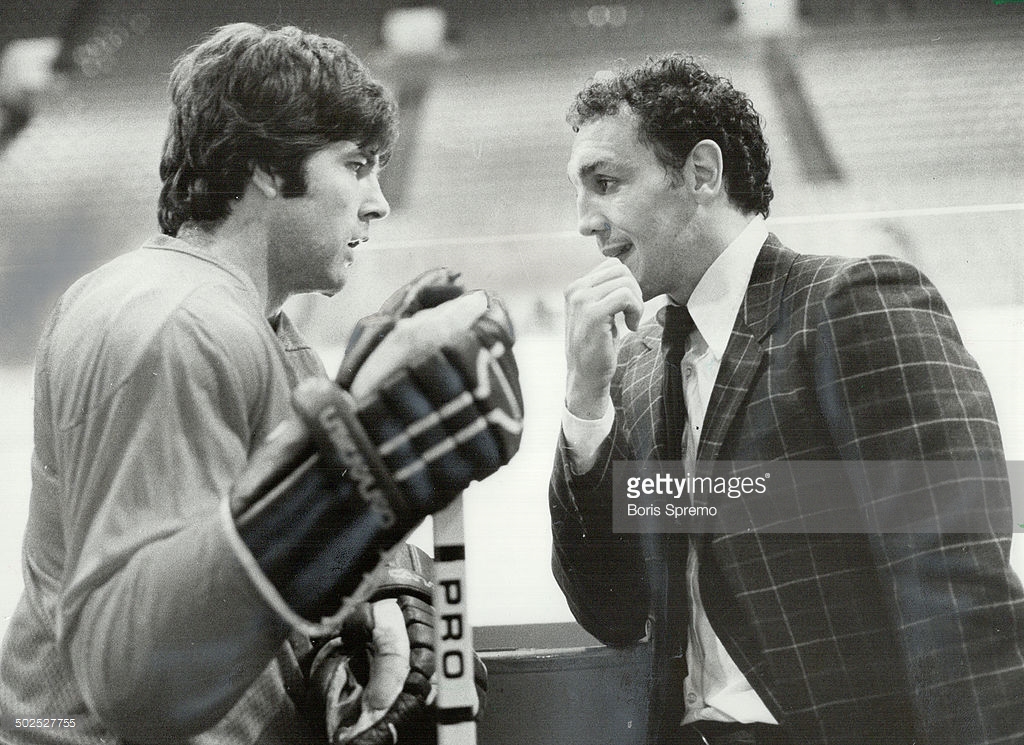
Turnbull, again, was the guy I was initially most excited about. He had size and could seemingly do a bit of everything — including fight, if necessary. But, while he showed flashes of obvious skill (and he had plenty of that), for me he never quite achieved the consistent level of play that would have made him a star.
He was not, in my view, especially effective at clearing the front of his net, had defensive deficiencies, and didn’t always seem that focused. He took way too many unnecessary penalties. Now, by all accounts, he was a guy who had a range of interests beyond hockey—which is great, obviously. But it did seem as though his immense potential was mostly just that—potential. Oh, he flashed at times (there was that five-goal night against the then-woeful Red Wings). But he was mostly a bit of an enigma.
Except when Borje Salming was injured (serious eye thing) in the playoffs in that series against the Islanders in the spring of 1978. For a few brief shining games against the Isles (and to a certain extent, even against the Habs in the next series) Turnbull was the guy we had all been waiting for—tough, smart, a leader, moving the puck spectacularly and playing solid defense. He seemed to do everything for the Leafs with Salming out of the lineup and the Leafs needing a boost. They would not, I am convinced, have beaten the powerful Islanders without Turnbull at his best (and rugged winger Dan Maloney, too).
Ian mostly played that way against Montreal as well. That summer of 1978, Leaf fans dreamed of how good Turnbull might finally become. He was 25 and in his prime.
But it never quite happened. The Leafs had another fairly nice season in 1978-79, but lost again to the Canadiens in four straight games (this time in the first round) and the “new”/old Imlach era began that summer of ‘79 — not too long after players like McDonald and Turnbull were gone.
Ian played for Pittsburgh and LA before retiring in the early ‘80s. At the time, his old Ottawa junior teammate in Potvin and the lslanders were in the midst of their four-year Stanley Cup dynasty.
We saw the best of Turnbull in Toronto, but only ever so briefly.
I still look back on that draft
For me, having watched the Leafs now and followed them closely for almost 60 years at this stage in my life, that was the draft that stood out and excited me the most as a fan. We picked up three really good players, and all of them certainly had nice careers in Toronto. But in each instance, Leaf fans were left wanting more: because McDonald should never have been traded away; because Turnbull had so much talent, and because Neely was perhaps not utilized properly.
Regardless, that was a heck of a draft—one I still remember fondly more than forty years later.























